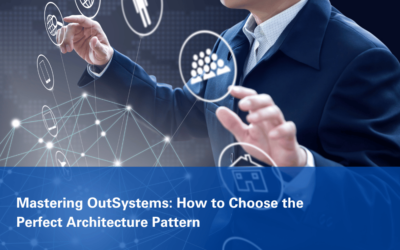Effective data management and integration are crucial for business success. OutSystems, a global leader in high-performance application development, has introduced OutSystems Data Fabric to enhance agility and productivity in low-code application development through seamless data sharing and integration.
As an IT leader or OutSystems user, you may have already heard the buzz around Data Fabric. Rather than covering the basics, this detailed blog article will dive into the intricacies of OutSystems Data Fabric and its architecture, offering valuable insights for leveraging this powerful tool to manage data more effectively in your business.
The Significance of OutSystems Data Fabric
OutSystems Data Fabric is designed to address the challenges of outdated data practices that can hinder developer productivity and business innovation. According to IDC research, outdated data can cost businesses over $15 million annually.
With OutSystems Data Fabric, organizations can centralize data management, accelerate application performance, and ensure smooth data integration across various systems. This not only helps in harnessing the full value of data-powered applications but also empowers business lines with the critical information they need.
Core Components of OutSystems Data Fabric
OutSystems Data Fabric integrates several key components that work together to provide a robust and efficient data management solution. Let’s explore these components in detail:
- Data Access– The data access layer is globally distributed, in-memory, and supports embedded, self-service, APIs, marketplace, and domain-driven access. This ensures that data is readily available and accessible across the organization, enhancing real-time data management capabilities.
- Data Modeling/Knowledge Graph: This layer involves data modeling, data products, and a graph engine. It plays a crucial role in structuring and organizing data, making it easier to manage and utilize. Data intelligence and AI/ML capabilities are integrated into this layer to enhance data insights and decision-making processes.
- Data Orchestration/Integration: Transformation, integration, and cleansing of data occur at this layer. It ensures that data from different sources is harmonized and prepared for further processing. The use of AI/ML technologies in this layer enhances the efficiency and accuracy of data processing.
- Data Processing/Persistence: This layer encompasses data lakes, data platforms for processing, and databases/NoSQL systems. It is responsible for the long-term storage and management of data, ensuring that data is readily available for use in various applications.
- Data Ingestion/Streaming: Ingestion, streaming, and data movement are managed in this layer. It ensures that data flows seamlessly from various sources into the data fabric, enabling real-time data processing and analysis.
Data Integration Patterns:
Effective data integration is critical for the success of any data fabric implementation. OutSystems Data Fabric supports various data integration patterns, including ERP (Enterprise Resource Planning) and CRM (Customer Relationship Management) systems.
These integration patterns enable organizations to consolidate data from different sources, ensuring that a unified view of data is available for decision-making.
Master Data Management:
Master Data Management (MDM) is a crucial aspect of OutSystems Data Fabric. It involves several components that work together to ensure the accuracy, consistency, and accessibility of master data across the organization. Key components of MDM include:
Microservices Strategy:
OutSystems Data Fabric supports a microservices strategy, enabling organizations to develop and deploy modular, scalable, and maintainable applications.
Microservices architecture allows IT teams to build applications as a collection of loosely coupled services, each responsible for a specific business function. This approach enhances application agility, scalability, and resilience.
Customizable Products and Intensive Batch:
OutSystems Data Fabric offers customizable products that can be tailored to meet the specific needs of different organizations. This flexibility ensures that businesses can leverage the data fabric to address their unique data management challenges.
Additionally, OutSystems Data Fabric supports intensive batch processing, enabling organizations to process large volumes of data efficiently. This capability is particularly important for businesses that need to handle substantial data loads and perform complex data transformations.
Event-Driven Architecture:
In tandem with Data Fabric, OutSystems has introduced an Event-Driven Architecture feature. This model shifts businesses away from legacy architectures and towards solutions that are more resilient, responsive, and easily scalable.
Event-Driven Architecture allows enterprise architects to eliminate the complexities of traditional request-driven models, providing the tools to build event-based applications in a unified hub. This centralization makes application management easier and less prone to disruption.
Benefits of OutSystems Data Fabric for IT Leaders
OutSystems Data Fabric offers several benefits for IT leaders, including:
- Enhanced Agility: By centralizing data management and integrating various data sources, IT teams can develop and deploy applications more quickly and efficiently.
- Improved Productivity: The automation of data integration and processing tasks reduces the time and effort required to manage data, allowing IT teams to focus on more strategic initiatives.
- Increased Data Accessibility: With a unified data fabric, organizations can ensure that critical data is readily available to decision-makers, enhancing data-driven decision-making.
- Scalability: The microservices strategy and event-driven architecture supported by OutSystems Data Fabric enable organizations to scale their applications and data management processes as needed.
- Security and Governance: Robust security and governance controls ensure that data is protected and compliant with regulatory requirements, reducing the risk of data breaches and other security incidents.
OutSystems Data Fabric represents a significant advancement in data management and integration for low-code application development. By providing a comprehensive solution that addresses the challenges of outdated data practices, OutSystems Data Fabric enhances agility, productivity, and data accessibility for organizations.
IT leaders looking to drive business success through effective data management should consider leveraging OutSystems Data Fabric to meet their innovation and IT transformation demands.









